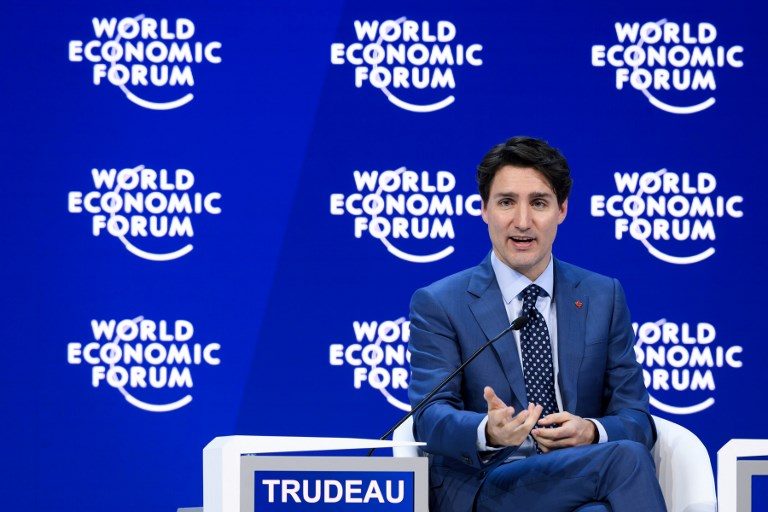SUMMARY
This is AI generated summarization, which may have errors. For context, always refer to the full article.

MONTREAL, Canada – Canada announced Tuesday, January 23, it will sign on the Trans Pacific Partnership, moving to diversify its trade relationships as Canadian, US and Mexican negotiators kicked off a sixth round of talks on a 1994 free trade pact that Washington has threatened to dump.
Canada had initially balked at joining the proposed TPP last year, acting as the main holdout in negotiations after US President Donald Trump decided in early 2017 to go it alone under his “America First” policy.
But with Trump also threatening to pull the United States out of the North American Free Trade Agreement and time running out to reach a deal on NAFTA, Canada found itself on the hot seat.
“We’re seeing a lot of trade skepticism around the world in general right now,” Canadian Prime Minister Justin Trudeau said in a speech at the World Economic Forum in Davos, Switzerland.
“People are worried or become increasingly convinced that trade deals benefit the few, not the many, benefit a country’s bottom line, benefit multinationals, but don’t benefit ordinary workers,” he said.
The prime minister described how governments must now “demonstrate convincingly” to workers the merits of free trade.
“That is what we’re working very hard on in NAFTA and I know that the work we were able to do with our fellow CPTPP partners at this point is going to be good not just for Canadians but citizens of the entire group of 11 countries in Asia that are part of this,” he said.
Canada’s decision to join the TPP, which has been rebranded the Comprehensive and Progressive Agreement for Trans-Pacific Partnership or CPTPP, came after two days of talks in Tokyo.
The parties will aim to sign the deal to create one of the world’s largest trading blocs by early March, said officials.
The agreement will incorporate all commitments from the original TPP, except for a limited number of provisions suspended temporarily, and some remaining issues to be finalized.
China is not included in the TPP, as the pact was initially driven by the former US administration as a counterweight to surging Chinese power in Asia.
NAFTA negotiations
In Montreal, Canada and Mexico, which is also a CPTPP member, signaled their readiness to offer concessions and to propose “creative solutions” to break a deadlock in negotiations and to ultimately convince the United States not to follow through on its threat to withdraw from NAFTA.
The pact, which Trump last week derided as “a bad joke,” binds nearly 500 million consumers, and provides Canada and Mexico with privileged access to the US market.
This sixth round of NAFTA negotiations “will be critical,” because the most contentious issues are on the agenda, according to a Mexican government statement.
“Everything will be on the table,” commented Canadian Trade Minister François-Philippe Champagne, noting that 28 of the 30 NAFTA chapters had yet to be revised.
In a sign of its hardening protectionist stance, the US administration on Monday imposed duties on washing machines manufactured in Mexico and South Korea, as well as on solar panels imported from China.
Trump, however, said Tuesday he believed the NAFTA talks were “moving along pretty well.”
“I happen to be of the opinion that if it does not work out, we will terminate it… so we’ll see how it all works out,” Trump said in the Oval Office.
The more contentious issues under consideration include adding a “sunset clause” that would automatically repeal NAFTA after five years unless it is renewed by the member countries.
Negotiators also will discuss the elimination of bi-national panels to resolve trade disputes, and Washington’s demand for stricter “rules of origin” for the automotive industry.
The current agreement specifies at least 62.5% of vehicle components must be manufactured in one of the three member countries in order to be exempted from customs duties.
The Trump administration proposed raising the bar to a minimum North American content of 85% and requiring 50% US origin. The US-made requirement irritates Mexico and Canada, but a compromise is still possible on the volume of regional content, according to sources.
The Trump administration also has called on Canada to abolish its supply-managed dairy and poultry sectors.
At the same time, Washington would like to drastically limit foreign access to US government procurement.
The Montreal talks are expected to last until January 29, making this the longest bargaining session since the start of the talks 6 months ago. – Rapplercom
Add a comment
How does this make you feel?
There are no comments yet. Add your comment to start the conversation.